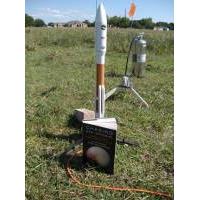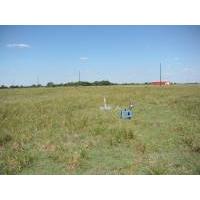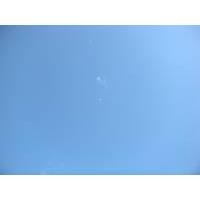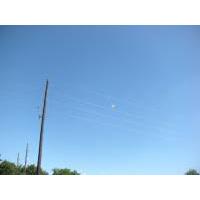DFR Technologies Atlas V AV551
DFR Technologies - Atlas V AV551 {Kit} (DFR-008A) [2013-]
Contributed by David Montgomery
| Construction Rating: | starstarstarstarstar |
| Flight Rating: | starstarstarstarstar |
| Overall Rating: | starstarstarstarstar |
| Published: | 2018-06-01 |
| Diameter: | 1.64 inches |
| Length: | 23.00 inches |
| Manufacturer: | DFR Technologies  |
| Skill Level: | 4 |
| Style: | Scale |

Brief
I bought this stunningly detailed kit several years ago to pay tribute to Dr. Alan Stern and his outstanding New Horizons team hard work and perseverance and remarkable success of the unmanned spacecraft, New Horizons, which on July 14, 2015 became the first man made spacecraft to make a close fly by of Planet Pluto after travelling over 3 billion miles for 9 1/2 years from Earth. The spacecraft was launched by the very versatile ULA Atlas - V AV551 rocket. I am, BTW, Facebook friends with a gentleman named Carl Campbell, who's a fellow model rocketeer and is also employed with ULA and founded/runs DFR Technologies (aka Real Space Rockets) that produces, market and sells the outstanding line of kits, mostly those used by ULA and NASA to launch various spacecrafts.
Components
The DFR Technologies Atlas - V New Horizons is a very highly detailed model. It is listed as a Skill Level 3 build.
This kit is an approximate 1/92th scale flying model of the United Launch Alliance (ULA) Atlas V Evolved Expendable Launch Vehicle (EELV). Atlas V’s have been in service since 2002 and launch from Cape Canaveral Air Force Station in Florida and Vandenberg Air Force Base in California.
This is a kit of the AV551 configuration, 5 Solid Rocket Motors (SRM). This kit includes the logo of NASA’s New Horizons probe that was launched on January 19, 2006. After launch the Atlas V deployed the planetary probe on its journey to Pluto.

This kit employs new technology parts and processes. The ABS plastic parts in this kit are made on-site at DFR Technologies using a professional grade 3D Printer. The 3D printed parts included are the highly detailed tail cone and other small detail parts. Additional features of this kit are clear laser cut acrylic fins and pre-wrapped vinyl body tubes for easier assembly and a realistic looking scale rocket.
Construction
I had no "Cons" in building this kit. The 3D printed parts are excellent, but the half nose cones of the SRBs is rather rough and will need lots of sanding to get smooth. I basically left mine as is, because you'd have to look very close up to see the rough surface and that's not really gonna happen if the model is sitting many feet away on the launch pad for flight. But built with care, the model (as with all of the excellent kits offered by DFG Technology) is a museum quality kit that you'll be very proud to display on your shelf.
Finishing
Individual parts and subassemblies do need to be painted as you go along the construction. But the pre-wrapped vinyl body tubes (payload section and main body section) is excellent and really makes this model stand out when finished. Also, the kit I received (if I remember correctly, I believe I ordered mine from JonRocket.com, but other excellent modroc vendors also sold this kit which is a bit rather pricey - at least between $70 - $90 depending on the vendor) came with the balsa nose cone (which is the one pictured shown in this product review), but subsequent run of this model came with a hollowed (but very strong) 3D plastic nose cone (one which I later received from Carl Campbell when I inquired about ordering from him). BTW, Carl and his DFR Technology company is very good in customer service.

Flight
The recommended engines listed for this model was the C11-3 and D12-5, but I believe you can use other, more powerful composite 24mm sized engines the size of the Estes C11 and D12
Recovery
For my model, and during construction, I decided to configure it to return via two separate pieces with their own parachute, using the kit provided plastic parachute for the upper (payload) section and using a similar sized nylon parachute for the main section. Because of the extra nose weight required to ensure the model is stable for flight (the three clear fins required for flight are somewhat small, but perfectly adequate as long as you make sure the CG is far forward of the model), I was concerned that having the model return on a single parachute may cause the dreaded "zippering" of the main body tube. Hence the reason why I configured mine to return in two separate pieces.
The first (and to date, only) flight I've had of this model was on May 6, 2018 down at our club's launch site in Needville, TX. One of the reason for holding this particular launch was to honor Dr. Alan Stern on his scheduled speaking engagement on May 12, 2018 at Space Center Houston along with his partner, David Grinspoon to talk about the New Horizons program and their newly released/published book, "Chasing New Horizons."
During the pre-flight prep, I added two ounces of additional nose weight (using Play Doh) to ensure the CG was as far forward for safe flight. The fully loaded model weighed in at 11.25 ounces. Looking at the engine specs chart in a recent Estes catalog, using the D12-5 was out of the question (max liftoff weight the D12-5 can fly is 10 ounces), so I went with the D12-3, which can safely lift up to 14 ounces.
Launch day that May 6th in Needville was almost superb weather conditions, mostly clear blue skies, low humidity with temperature around 83 degrees and very little wind (averaging about 4 - 7 mph). The D12-3, as it turned out, was perfect for this launch. The flight trajectory was perfectly straight up, and on burnout, the model did wobble a bit, corrected and then continued to coast upward (straight) for a pretty good distance (I suspect the extra mass due to the weight of the model was the reason) before the ejection charge activated exactly at apex.
The two separate parachutes fully deployed and both sections returned safely, although the main body section did cause a scare when it got snagged by the electric lines running along the street near the launch site. I started to write that incident off as a loss, but at some point, the little wind that was blowing did allow the model to "flop over" the power lines and have it fall to the asphalt road below. Only damage on recovering that main section after it fell to the road was one of the SRBs broke off (easily repairable).

Summary
Excellent and beautiful model. Carl Campbell really raised the bar on quality and detailing of this and the other kits offered by DFR Technology. Models are really so nice that one is almost afraid to fly these models. But you gotta remember that it is NOT a model rocket if it isn't flown.
Related Products
 |
 |
Flights
Sponsored Ads
 |
 |















